LESSON 9: The Principles of Card Effects
Card tricks fill an important place in the realm of Magic. These tricks are based on sleight of hand and on mechanical arrangements.
Sleight of hand is a great art. It involves very definite principles which must be practiced a great deal. I give you here the principles which form the foundation for the card effects depending on sleights. These principles are not difficult to master, but they do require careful thought, study and practice. These principles are the backbone of Magic, and once you master them you have a wonderful foundation for building your card effects.
In Card Magic are also included the fancy sleights and flourishes that some Magicians use. These really belong to the field of the juggler, however, not to the magician. My aim is to teach you Magic which mystifies and not jugglery which is merely a mechanical accomplishment gained from years of practice.
Practice these principles faithfully. You will be delighted to notice your improvement in performing each time you try. I list here the principles which you must master to perform the effects given you in this lesson. The explanations of the working of the principles are embodied in the explanations of the effects in their proper places:
1 - The simplified pass.
2 - The false shuffle.
3 - The double card lift.
4 - The slip change.
5 - The palming of a card.
The mechanical arrangements involved in the effects are:
1 - Production of selected card from closed card case.
2 - The slit corner envelope.
3 - Doubling first card in fan.
I hope you realize the importance of this lesson and the need for your absolutely mastering it before you perform any of the effects. You are not expected to be able to do these card tricks with only a little practice. Some of the effects in earlier lessons required only a short time of study and you were able to perform them well, but you must put real study and practice into these effects. There are many people who know card tricks, but they do not know these which depend on principles. And so if you train yourself to be a finished card performer, you place yourself way above the ordinary amateur.
1. THE RISING CARD ESCAPE
Rising card tricks have been very popular in Magic. There are many methods of producing the effect, but most of them are mechanical arrangements. The method I give you is impromptu, so that you can perform it with an ordinary deck of cards at any time and in any place. In this method you use some sleight of hand and the very simple mechanical arrangement of closing the card case.
EFFECT:
Spectator draws a card from deck of playing cards and shows it to audience. He replaces it in deck and shuffles it in. Performer then places deck in cardboard case and closes the flap down. Then he requests spectator to tie case onto empty right hand with a handkerchief. Upon magician's command the selected card rises from the deck, apparently through the case.
PARAPHERNALIA:
1--A deck of playing cards.
In card Magic you will find the best cards to use are Bicycle or Bee Cards. Some magicians like Steamboat cards. The favorite Steamboat pack is the one with the red and black lined backs, which gives a brown effect. Blue back cards are best, however, because the blue color is least detectable in sleights. A new deck is preferable to an old one. When you borrow a deck, however, you must use what you get. 2--A borrowed handkerchief.
SECRET AND PATTER:
To Perform: Remove cards from case and give to spectator to shuffle.
"Please, sir, take out any card you choose and give me the rest of the deck."
Take cards from spectator.
"Remember the card you have selected, and if you care to, you may show it to a neighbor or two. Now return your card to the middle of the deck."
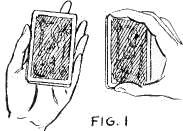
Cut deck into two equal portions. To do this, hold deck in left hand, backs of cards up. Place thumb of right hand at bottom edge of cards and first, second, and third fingers at top of deck. It is then easy to lift up the top half of deck. See Figure 1.
Have spectator place his card on the lower half of deck.
THE SIMPLIFIED PASS:
Place top half of deck which is in right hand on lower half which is in left hand. As you do so insert little finger of left hand between the two halves of deck, as in Figure 2.
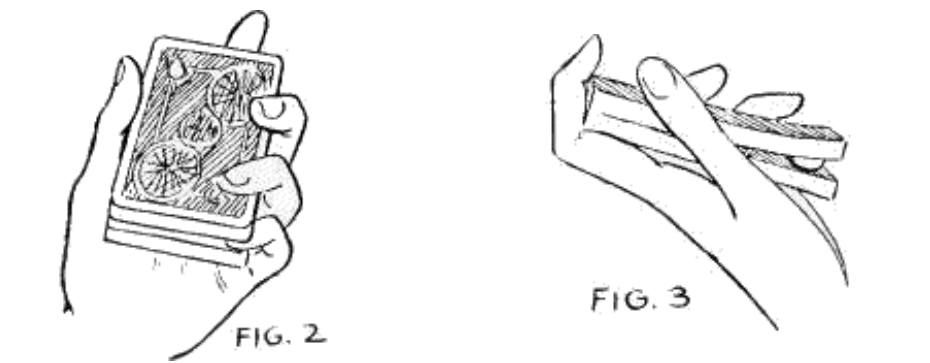
The front part of deck is allowed to come together in an ordinary manner, but the back part is divided by the little finger. Audience thinks two halves have been brought together and selected card lost in center of deck.
Practice this much carefully before the mirror until you can do this naturally and insert your little finger so that no one can notice it.
Figure 3 shows the position of your left hand now. Your thumb is at the left of the pack, your first finger is at the front end, your second and third fingers are at the right, and your little finger is at the back between the two sections of the deck.
Turn left hand toward right bringing thumb end up.
Using little finger as a lever, push top half of deck out a little and grasp it with right hand. See Figure 4.
Your object is to get the selected card to the top of the deck. This card is now the top card on the lower section of the deck which you have divided by little finger of left hand. To accomplish this you perform THE SIMPLIFIED PASS in this manner:
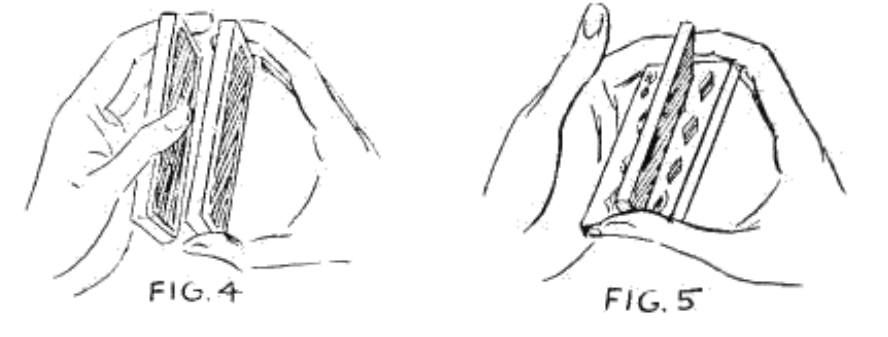
With right hand place top half in front of lower half of deck and shuffle cards toward front of deck, faces of cards toward audience. See Figure 5. This must be all done with one movement. Do not put the top pile of cards down in front of the others and then start shuffling. Do your shuffling right from the movement of the Pass.
This is called a FALSE SHUFFLE to keep selected card at top of deck — explanation of this follows:
THE FALSE SHUFFLE:
In this type of false shuffling the point is to actually shuffle the cards but not to place any cards over the top card. See Figure 6. Shuffle toward the front of the deck.
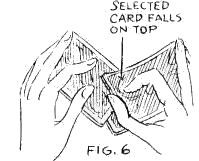
If you do a riffle shuffle, riffle two halves of deck into each other but BE SURE THAT YOU LET TOP CARD FALL ON TOP WHEN THROUGH.
You must learn to do this shuffle naturally.
Audience now believes that card was returned to middle of deck and its position lost by shuffling. To prove card is lost in deck another ruse is used.
DOUBLE CARD LIFT:
Chosen card is at top of deck, but you are going to prove that it is not there.
Hold deck in left hand, backs of cards up. With right thumb lift up lower left corner of "two" top cards, as illustrated in Figure 7.
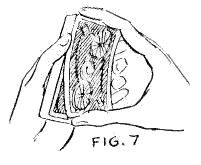
Pick up the two top cards and show them as one. See Figure 8. To the audience it looks like you are holding only one card. And that card is not the selected card.
"By the way, the top card did not happen to be your card, did it? No? Then it has! been lost somewhere in the pack in the shuffle."
After showing card, return the two to the top of the deck.
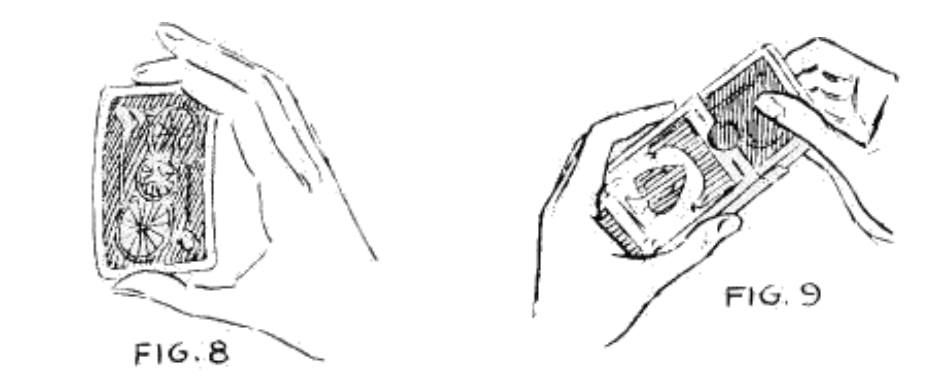
Pick up card case and show it empty. You may give it to spectator for examination.
Place deck in case with face of cards toward flap of box, as illustrated in Figure 9.
Push down the two small side flaps of case, then bring large flap over cards, and insert it apparently enclosing whole deck in the case. This is what you really do. Place the tip of left index finger on top of selected card and pull it back about an eighth of an inch from rest of pack. See Figure 10. This allows enough space into which to force the flap of card case. Push flap down.
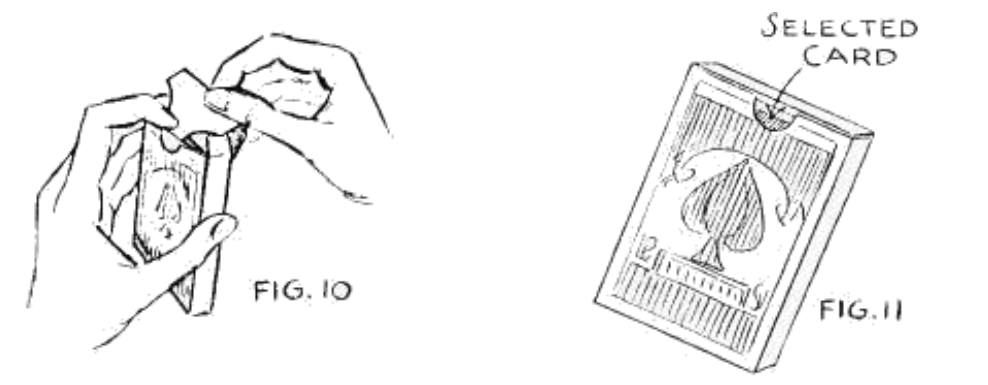
You now have chosen card between back of box and the flap. See Figure 11. As box and card are same color the box can be thrown about rather carelessly and can be shown hurriedly without fear of detection. The audience will not suspect that you have not enclosed all of the cards in the case.
You may show case at close range by holding thumb of left hand over part where card shows. See Figure 12. Show case freely to prove that cards are really enclosed in it.
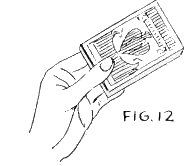
"I should now like to borrow a handkerchief."
Ask spectator who lends handkerchief to roll it up rope fashion.
"Please roll the handkerchief rope fashion. Now will you please tie the deck of cards onto the palm of my right hand?"
Show right hand freely, both sides, spreading fingers wide apart. Also show both sides of case. Then place case on right palm with part showing selected card against the hand and toward tips of fingers, as in Figure 13.
"Tie it rather tight so that it will not slip."
Spectator ties handkerchief around case and hand, knotting it at the back, as illustrated in Figure 14.
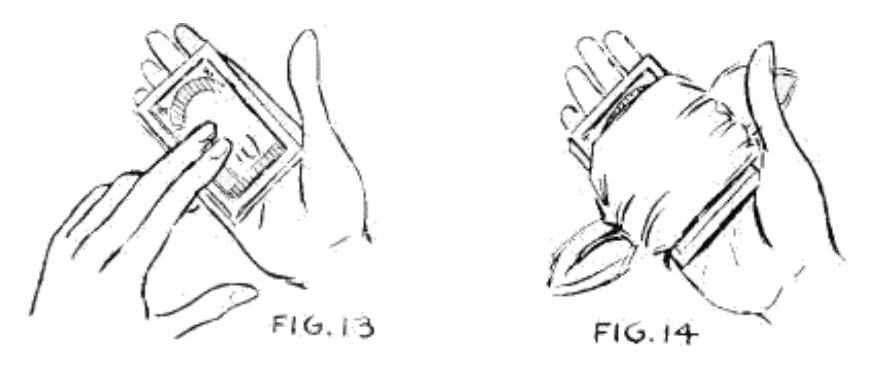
"Let me convince you again that there are no cards in my hand or outside of the case."
With left hand lift up edge of case, covering selected card with first two fingers, to show audience that there is nothing between case and hand. Lift up lower end of case also.
"Now, sir, will you please tell me what card you selected? The Jack of Spades? Thank you. (We will assume here that the selected card was the Jack of Spades, but any other card would do just as well.) Well, the Jack of Spades is somewhere in this card jail. You know he is a slippery fellow. Would you mind calling him?
Say, 'Here. Jack, here, Jack. Come here, Jack'"
When spectator calls, you place second finger of right hand against card in case and push card slowly out of case.
Push card out about three-quarters of an inch, then release it and return finger to top of case and push card up again a little way. Then repeat this motion. If it is done properly, card will appear to rise slowly out of box. Keep the motion smooth, not jerky and your effect will be good. See Figure 15.
"Prison walls do not a prison make -- and out comes the Jack."

When the Jack has risen almost entirely out of the box, as in Figure 16, take it out with left hand and give it to spectator or lay it on the table.
"This is your card, is it not? And the rest are still in the deck and snugly tucked into the box."
Slip case from hand and remove handkerchief. Show case on both sides. Open flap, remove deck, and fan deck (spread it out fanwise) to show cards freely. Return borrowed handkerchief.
"The moral of which is -- it is a wise card that does not sleep fifty-two in a bed."
2. SEALED CARD MYSTERY
EFFECT:
Performer gives deck to spectator to shuffle thoroughly and then to select a card. Spectator passes the deck to two other spectators who in turn each select a card. Performer does not touch pack during selection of cards. Each spectator is asked to place his card in a small envelope and seal it in. Then each seals small envelope into a larger envelope. Performer divides deck into two sections. He shows top card on each section. Then one of the envelopes is selected. Spectator is asked to lift off top card of each section and it is found that they have changed and that one of the cards shows the suit and the other the number of the selected card. Envelope is torn open and the prophesied card is found therein.
PARAPHERNALIA:
1--Three small opaque manila envelopes, such as used for church collections or pay envelopes — size: 2 1/2 x 4 1/2 inches.
2--Three standard size manila envelopes — about 6 1/2 x 3 1/2 inches. See Figures 17 and 17A.
3--A deck of playing cards.

SECRET AND PATTER:
To Prepare: Take one of the small envelopes. With the scissors cut off a very fine edge on the lower right side of envelope — cut up about 1-1/4 inches from bottom and about 3/4 inch along bottom. See Figure 18.
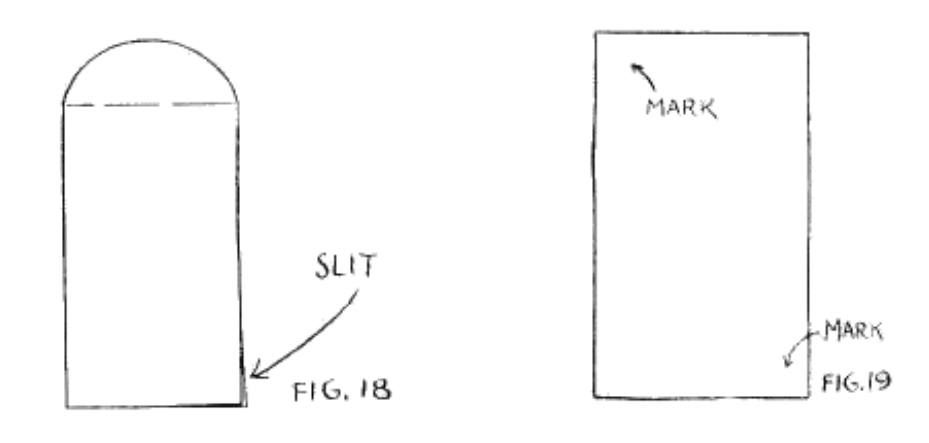
On one of the large envelopes put a pencil dot at the upper left corner and at the lower right corner on both sides. See Figure 19. This is done to enable you to identify this envelope at a glance from among the three envelopes.
To Perform: Have envelopes on table nearby. Take deck of cards in hands and fan them to show that they are ordinary playing cards. Never say in words, "I have here an ordinary pack of playing cards." Use the POWER OF SUGGESTION by fanning cards.
"Will you, sir, please shuffle this pack of playing cards. Shuffle them well." Give deck to spectator to shuffle.
"Now remove any card, look at it, but do not let me see it. Then pass the deck to someone else."
Spectator selects card and passes deck to another member of the audience.
"Take any card out and remember it. Do not let me see it. Then you give the deck to someone else, too." Card is removed and deck passed to a third spectator.
"In a like manner take out any card, remember it, and do not let me see it. I will take the deck, if you please."
Third card is removed by third spectator. You take deck and place it in full view on table. Pick up an unprepared small envelope and hold in left hand.
"Will the person who drew the first card please place it face down, so that I cannot see it, in this envelope?"
Hold envelope toward spectator so that card can be inserted, as in Figure 20. Wet flap and seal. Take a large envelope from table, open it, and drop small envelope with card into it. Then you request spectator to seal large envelope.
"Will you, please, seal the envelope and hold it for a while?"
Now pick up prepared small envelope. Hold slit corner together with thumb and first finger of left hand. Hold envelope toward second spectator as you did the first one.
"And will you, please, place your card in this other envelope, face down so that I cannot see it?"
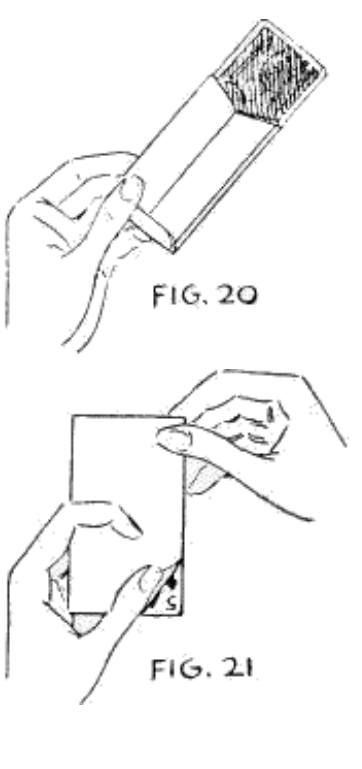
Second spectator inserts his card. With first or second finger of your right hand, push card well against bottom of envelope. Wet flap of envelope and turn it toward audience. As you seal down the flap with right hand, WITH LEFT THUMB LIFT UP SLIT CORNER OF ENVELOPE AND LOOK AT
NUMBER AND SUIT OF CARD. See Figure 21.
You can see at a glance what the card is inside of the envelope. Let us say it is the 5 of spades. Allow corner flap to fall back in place. Audience is watching you seal flap of envelope, and if you hold the envelope tilted upward, they will never suspect what you are doing, as they cannot see rear of envelope.
Take prepared large envelope — the one with the dots in the corners — from table. "Again we will seal the card and envelope in still another envelope." You place envelope into larger one and seal it yourself.
"And I will have the lady (or gentleman) here hold it."
Give envelope to spectator to hold. Take other small envelope from pocket.
"We will have the last card sealed into the envelope also."
Card is placed in envelope by spectator and flap of envelope is sealed.
"And then we will place it also in the larger envelope."
Small envelope is placed in third large envelope and flap of envelope sealed.
"Please hold the envelope."
Go back to table. Pick up deck of cards. Fan it open slightly so that you can look through it hurriedly. You must now locate two cards, one with the suit and the other with the number of the card which you have in the slit envelope. We are assuming that the card in the slit envelope is the 5 spot of Spades. Look through deck quickly for a 5 spot of any suit and when you have found it place index finger of right hand back of it. See Figure 22.
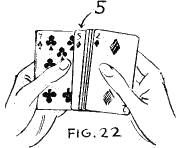
Continue running through cards until you come to a spade. When you do, lift it out with as little movement as possible and slip it in front of index finger of right hand. This places the cards in the following order:
Lower section of deck held in left hand.
A spade card of any number.
A 5 spot card of any suit.
Upper section of deck held in right hand.
Right index finger is held between lower and upper sections of deck.
Now divide pack into two portions, holding them about a half inch from each other, as in Figure 23.
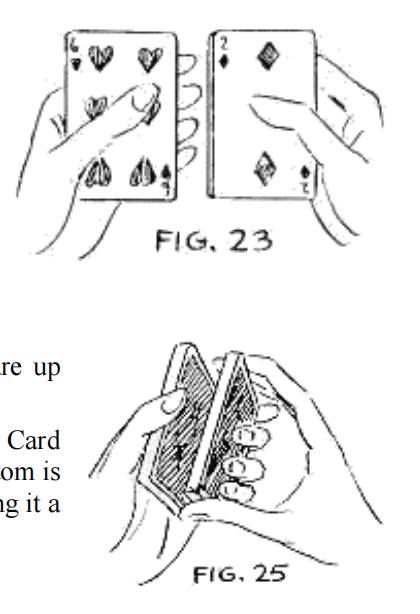
"Guess that this is a full pack. Oh, well, it doesn't matter."
Place section of deck in right hand under that in left hand and square up cards.
The spade card and the 5 spot are now on the top of the pack. In Card Magic, the top of the pack is always the side with backs of cards up and bottom is side with faces of cards showing. Turn pack over and riffle shuffle it -- giving it a FALSE SHUFFLE, so that two top cards remain on top.
Now hold pack in position shown in Figure 25.
THE SLIP CHANGE:
Keeping lower edge of deck together, open up upper edge of deck about in the middle. Figure 26. Press hard with left fingers against top card of right-hand section of deck.
Lift out all of right-hand section of deck with the exception of top card, Figure 27. Hold this card securely with left fingers.
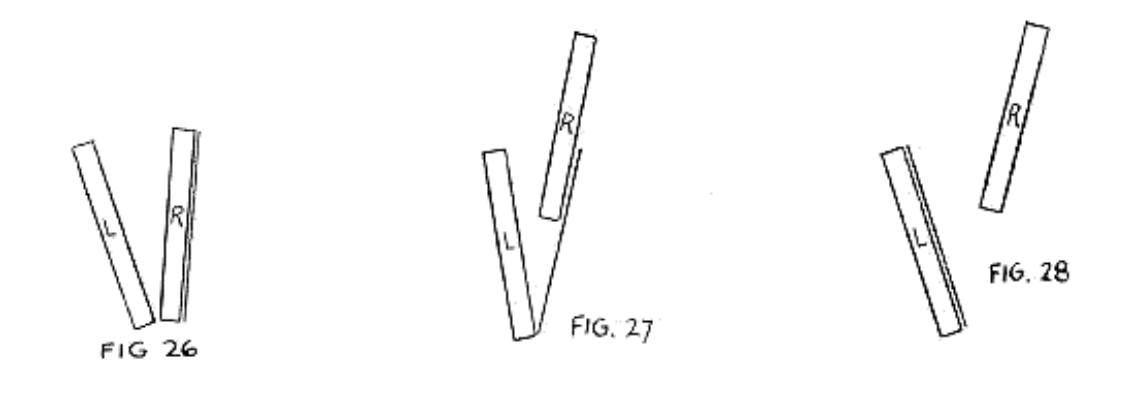
When you remove right-hand section of deck with right hand, top card automatically falls against the cards in left hand and so becomes the top card of the left-hand half of deck. Figure 28.
This move in which a card on one section of a deck is slipped over onto the top of the other section is called THE SLIP CHANGE- Practice this over and over again. Keep a firm grip on card to be slipped with left fingers. You must acquire ease and quickness in performing this move. Also study the ANGLE OF VISIBILITY for the move before your mirror.
Place the two sections of deck on table, faces of cards down.
"Let us see what card is on top of this packet."
Take left-hand packet and do the DOUBLE CARD LIFT, lifting the two top cards as one. Call out the card and replace. The top card is really a spade, but the audience is not aware of this. "Queen of hearts." (Or whatever the "second", card may be.)
Replace pack on table. Do the DOUBLE CARD LIFT on other section of deck.
"The top card on the other packet is the ten of diamonds." (Or whatever the "second" card in this half of the deck may be.)
Replace double card on pile again.
"Do you believe in fortune-telling? Fortune-telling with cards? Whether you do or not, I want to show you something peculiar about card prophecies. Will someone take all three of the envelopes, please — those which my good friends are holding, and mix them up well?" Someone collects three envelopes and mixes them up.
"Now, spread them out and I will take one."
Reach over and take the one with the dots marked on it.
"I guess this one is as good as any. I wonder what card is in it. I don't suppose the Old Nick, himself, knows. But that is where fortune-telling with cards comes in. On the table we have two piles of cards. On the one is the Queen of Hearts, on the other is the Ten of Diamonds. We will ask the spirit of the great gypsy fortune teller to come down and tell us with these cards which card is in the envelope. First, good gypsy, tell us
the suit. Is it a heart, a spade, a club, or a diamond? Hark, I hear foot prints of the spook." Lift off top card on left-hand pile. It is the Spade card. Show it to the audience.
"A Spade. Now tell us, kind spirit, what is the number on the card? Is it a deuce, a six spot, a King — or what?"
Lift off 5 spot on right hand section.
"A 5 spot. Then the card in the envelope is the FIVE OF SPADES. Who selected the 5 of Spades? You, sir? Thank you."
Tear open large envelope quickly. Remove smaller envelope, carefully concealing slit corner with fingers of left hand. Tear open flap end, then place forefinger of right hand inside envelope and rip open side and bottom, allowing card to come out. If you have a knife handy, you may slit side and bottom of envelope with it. This destroys the evidence of the slit corner.
Hold up card and show it so that all can see it.
"The 5 of Spades is correct. Please tear open the other envelopes and I will replace the cards in the pack."
Envelopes are torn open by spectators and cards given to performer. Magician shows them and calls them in order to convince audience that different cards were placed in each envelope.
Pick up sections of deck from table, replace selected cards, and square up the deck.
NOTE: When you call out cards, put vigor into your voice. Be sincere and convincing in your manner. BE POSITIVE. Do not hesitate or stammer or you will lose your effect. Here again the POWER OF SUGGESTION applies. If you are positive in your actions, you will convince your audience and put over your tricks.
THE SLIT CORNER ENVELOPE:
The envelope with the slit corner may be used for experiments in which you do card mind-reading. You can read any card placed in the envelope very easily by simply raising the slit end of the envelope.
You may try a Mind-Reading effect of this nature: Have a selected card placed in the envelope. Follow directions given in preceding effect for sealing flap of envelope and at the same time looking at the card. Then hold envelope to forehead and name the card in it. Then slit envelope open as directed in preceding effect, to destroy evidence, and show card.
In mental effects of this kind, you must use SHOWMANSHIP to work effectively. For instance, in this effect, do not simply say, "The card in the envelope is the Two of Diamonds."
Work your patter up to something like this, "I get an impression — the card is a red one — it vibrates like a heart — No, it is a Diamond — the Two of Diamonds."
I give you this suggestion because I want you to start working up your own effects from the principles I
have taught you. You will find it fascinating to originate your experiments and your patter. Start now to try to do this.
4. A PSYCHOLOGICAL IMPOSSIBILITY
EFFECT:
Performer picks up a number of cards from a shuffled deck, fans them out, and asks someone to select a card. Spectator who makes the selection is asked to remember which number from the end this card is. Performer closes up cards and places them on table. He then picks up remainder of pack and asks another spectator to remove any card but not to look at it. Magician places this card in his pocket. First spectator then tells what number from the end of first section of deck his card was. Magician looks through this first pile and finds that card is not there. He removes the card which was selected from the second pile from his pocket and first spectator finds that this is the card which he selected mentally from the first pile.
PARAPHERNALIA:
1--A deck of playing cards.
SECRET AND PATTER:
To Perform: Have deck of cards well shuffled.
Pick off about a third of the deck, as in Figure 24, and place the rest of the deck in full view on the table.
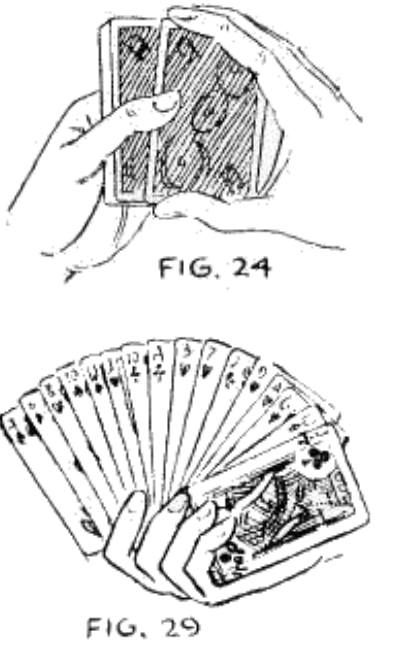
Place the third of the deck in left hand.
With right thumb lift up lower left corner of TWO TOP CARDS about an inch. Move the two cards over to the right as ONE. Then fan the rest of the pack to the left with left hand. It appears that you are showing all the cards in the pack to the audience, but in reality the last card in the fan is a double card (two cards together.) Your left side should be turned toward audience. See Figure 29.
"I have here a number of cards spread fanwise and I want someone to think of a card and remember the position of it in the pack — that is, what number it is from the top. For instance, starting from the end (Performer's right side), one, two, three, four, five, six, the sixth card is the Jack of Hearts. Or, for instance, you choose the seventh -- the Ten of Clubs. Choose
any card, but remember the number it is from the end. Have you thought of a card? Have you it well in mind, and its position from the end? All right. Then I will just square up these cards and lay them on the table."
After spectator has thought of card, square up the little pile and place it in full view on the table. Then show both hands empty, both sides, fingers wide apart.
Because of the extra card behind the first one which spectator saw, the card he selected is one card farther from the end than he thinks. If spectator mentally chose the sixth card, this card is really seventh from the end, etc.
"Now, watch me carefully. I pick up the other pile of cards and ask you, sir to take them in your own hands and take out any card you choose. However, do not look at it, or show it to anyone." Spectator removes card. "Give card to me." Spectator gives you card.
"And I will place it in my pocket."
Holding card with back to audience in your right hand, place it in your right trousers' pocket.
"Now square up the pile of cards in your hand and place it on the table. We are now ready for the mental miracle or what psychologists say is an impossibility. It is the psychologists' dream." Point to cards at right, from which spectator mentally selected a card.
"Now if I were to tell you that the card you thought of in this pile of cards is the one that was selected from this other pile and the one that I placed in my pocket -- you would think this is a pretty good trick, wouldn't you? And I assure you, too, that there are no two cards alike in the deck. Let me prove to you that what I say is true."
Pick up cards at right and hold in left hand, BACKS OF CARDS UP. "By the way, what number from the end was your card?" Spectator tells you — for instance, Five.
"The fifth card -- let us see."
Count cards, backs up, slowly and distinctly one at a time into the spectator's hand. When you have counted off five cards, the sixth and selected card is now the top card.
Bring right hand back to pack and with thumbs of both hands slide the top card, which is the selected card, about three-eighths of an inch to the right. Lift up lower right edge of this card far enough to get first joint of little finger of left hand between it and rest of pack. Square up all the cards, leaving little finger under the top card. See Figure 30.
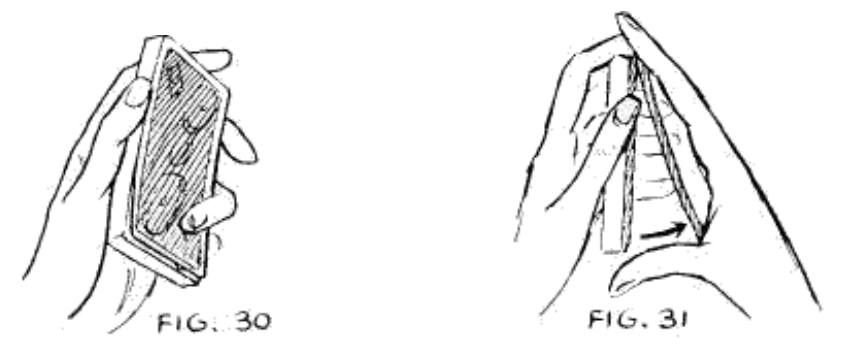
DO THIS WITHOUT LOOKING AT CARDS. YOU MUST LOOK AT SPECTATORS AND USE MISDIRECTION WHILE DOING THIS MOVE.
"If you thought of the fifth card, then it must be the one you have there in your hand. Look at it and see."
Point at spectator's hand with your right hand. As he looks at card, you bring your RIGHT hand over to the deck in your left hand. Raise top card with little finger of left hand and propel it into right palm. See Figure 31.
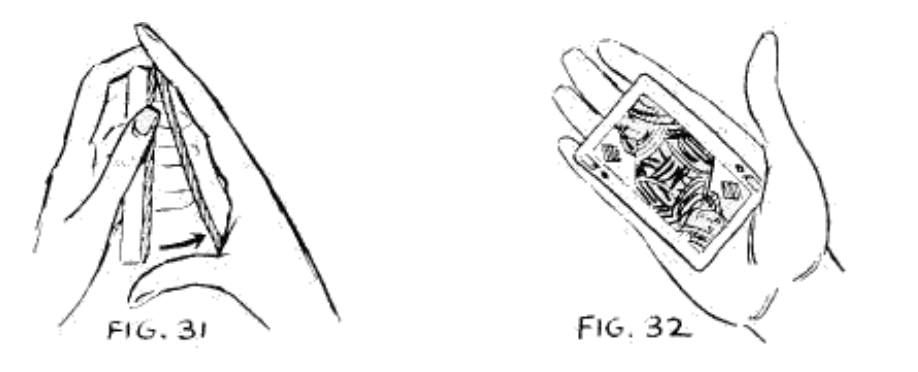
PALMING OF A CARD:
Curl fingers of right hand slightly over card. This will hold card in right palm, as in Figure 32.
Proficiency in palming a card is essential to your success in Magic. Practice it. You must keep back of
hand to audience and keep card screened from view, as in Figure 33. Remember NATURALNESS of the hand and ANGLES OF VISIBILITY.
"Is that your card?"
You refer, of course, to the fifth card, which he has in his hand.
"No? Then, what was your card?"
Spectator calls out the selected card, say the Queen of Diamonds. You repeat,
"The Queen of Diamonds."

With card palmed in right hand reach suddenly into right trousers' pocket where you placed second selected card.
Now remove the Queen of Diamonds from your pocket. This is, of course, the card which you just palmed in your right hand and placed in your pocket. The other card remains there.
Use showmanship in producing the Queen from your pocket. Bring out the top edge and slowly turn it around so that audience can see it. Put an element of suspense into the producing of the card.
"Then I was right after all. You see the card you thought of in one pack was the one you selected from the other pack and which I placed in my pocket."
Dispose of card still in pocket by placing whole deck in pocket and then bringing it out again with card or by palming card and bringing it out and placing with rest of deck, or leave it there if not in the way until an opportunity comes of secretly removing it. Do not be in a hurry to get card out of pocket.
TARBELL SYSTEM, INCORPORATED, Chicago.
LESSON 10
You have reached a certain goal by this time in your study of the Profession of Magic. I know you have been performing informally with the effects which I have given you already, but now you are ready to give a real performance.
Lesson 10 is a wonderful lesson. It teaches you:
1 -- SHOWMANSHIP —
Details involved in the proper presentation of a program.
2 -- HOW TO ARRANGE SEVERAL PROGRAMS —
Programs to suit you, to suit the audience and to suit the occasion.
3 -- How to present a complete program or show with what you have so far learned.
Bạn đang đọc truyện trên: truyentop.pro